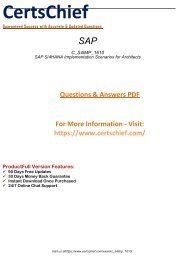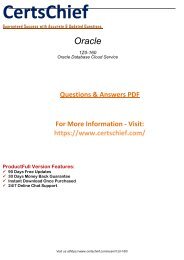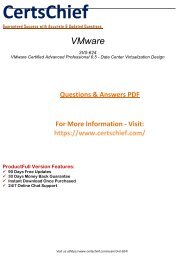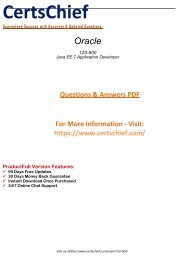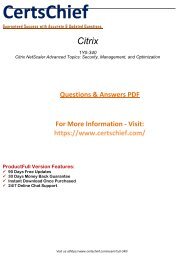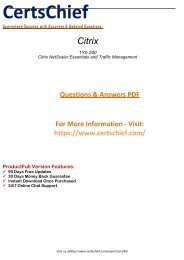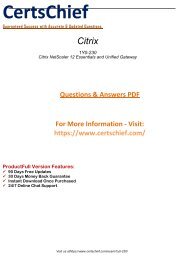1Z0-067
Study units and arrangement materials gave by us to 1Z0-067 Test are approved by the experts and industry specialists. You can without much of a stretch breeze through your accreditation test with our cerebrum dumps and PDF test questions. please use 20off2018 as discount voucher to avail 20% discount. For more information please visit here: https://www.certschief.com/exam/1Z0-067/
Study units and arrangement materials gave by us to 1Z0-067 Test are approved by the experts and industry specialists. You can without much of a stretch breeze through your accreditation test with our cerebrum dumps and PDF test questions. please use 20off2018 as discount voucher to avail 20% discount. For more information please visit here: https://www.certschief.com/exam/1Z0-067/
Create successful ePaper yourself
Turn your PDF publications into a flip-book with our unique Google optimized e-Paper software.
Question: 1<br />
Which two statements are true about scheduling operations in a pluggable database (PDB)?<br />
A. Scheduler jobs for a PDB can be defined only at the container database (CDB) level.<br />
B. A job defined in a PDB runs only if that PDB is open.<br />
C. Scheduler attribute setting is performed only at the CDB level.<br />
D. Scheduler objects created by users can be exported or imported using Data Pump.<br />
E. Scheduler jobs for a PDB can be created only by common users.<br />
Answer: B,D<br />
Explanation:<br />
In general, all scheduler objects created by the user can be exported/imported into the PDB using data<br />
pump. Predefined scheduler objects will not get exported and that means that any changes made to<br />
these objects by the user will have to be made once again after the database has been imported into the<br />
pluggable database. However, this is how import/export works currently. A job defined in a PDB will run<br />
only if a PDB is open.<br />
Question: 2<br />
A complete database backup to media is taken for your database every day. Which three actions would<br />
you take to improve backup performance?<br />
A. Set the backup_tape_io_slaves parameter to true.<br />
B. Set the dbwr_io_slaves parameter to a nonzero value if synchronous I/O is in use.<br />
C. Configure large pool if not already done.<br />
D. Remove the rate parameter, if specified, in the allocate channel command.<br />
E. Always use RMAN compression for tape backups rather than the compression provided by media<br />
manager.<br />
F. Always use synchronous I/O for the database.<br />
Answer: B,C,D<br />
Explanation:<br />
Tuning RMAN Backup Performance: Procedure Many factors can affect backup performance. Often,<br />
finding the solution to a slow backup is a process of trial and error. To get the best performance for a<br />
backup, follow the suggested steps in this section: Step 1: Remove RATE Parameters from Configured<br />
and Allocated Channels Step 2: If You Use Synchronous Disk I/O, Set DBWR_IO_SLAVES Step 3: If You Fail<br />
to Allocate Shared Memory, Set LARGE_POOL_SIZE Step 4: Tune RMAN Tape Streaming Performance<br />
Bottlenecks Step 5: Query V$ Views to Identify Bottlenecks<br />
https://docs.oracle.com/database/121/BRADV/rcmtunin.htm#BRADV172<br />
Visit us athttps://www.certschief.com/exam/1z0-<strong>067</strong>/



